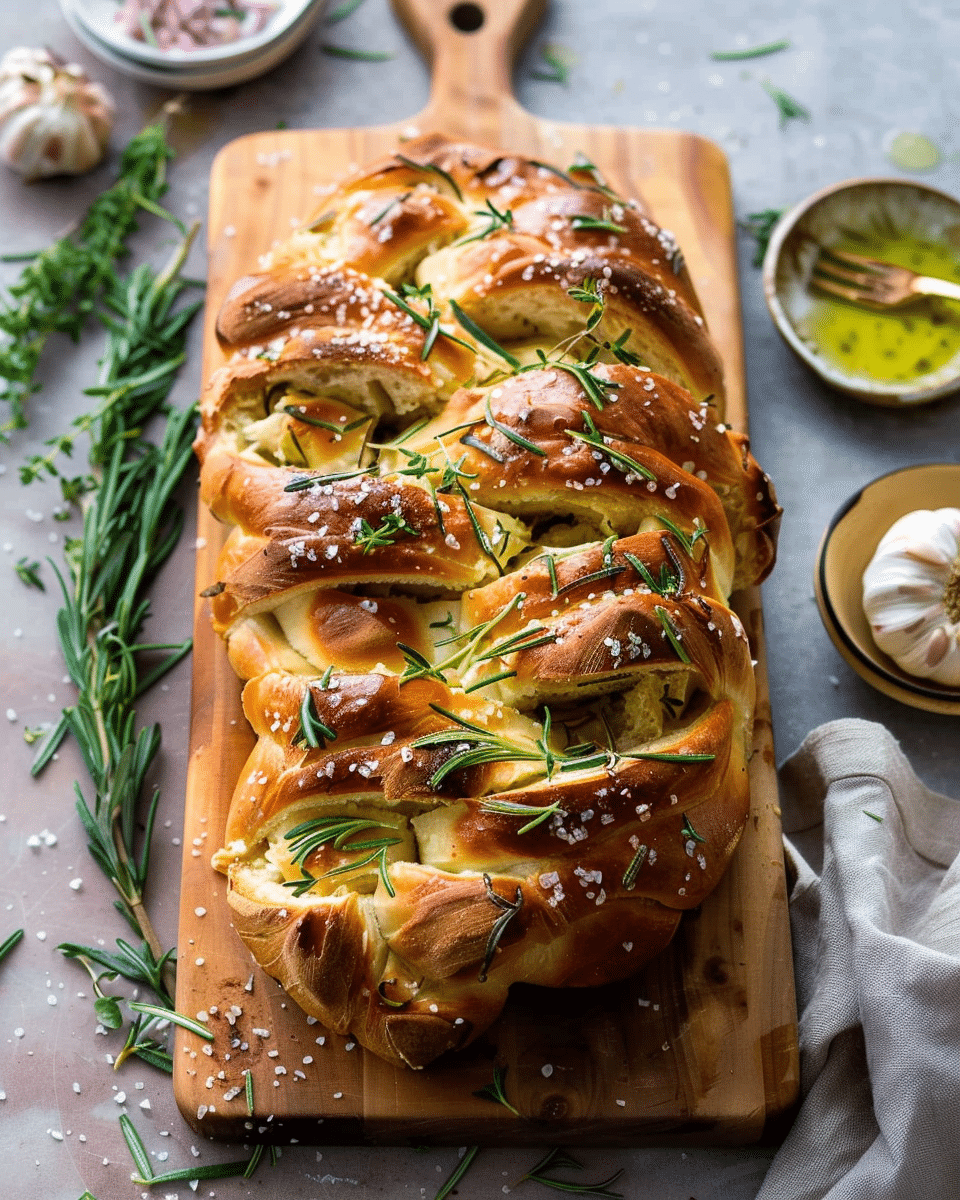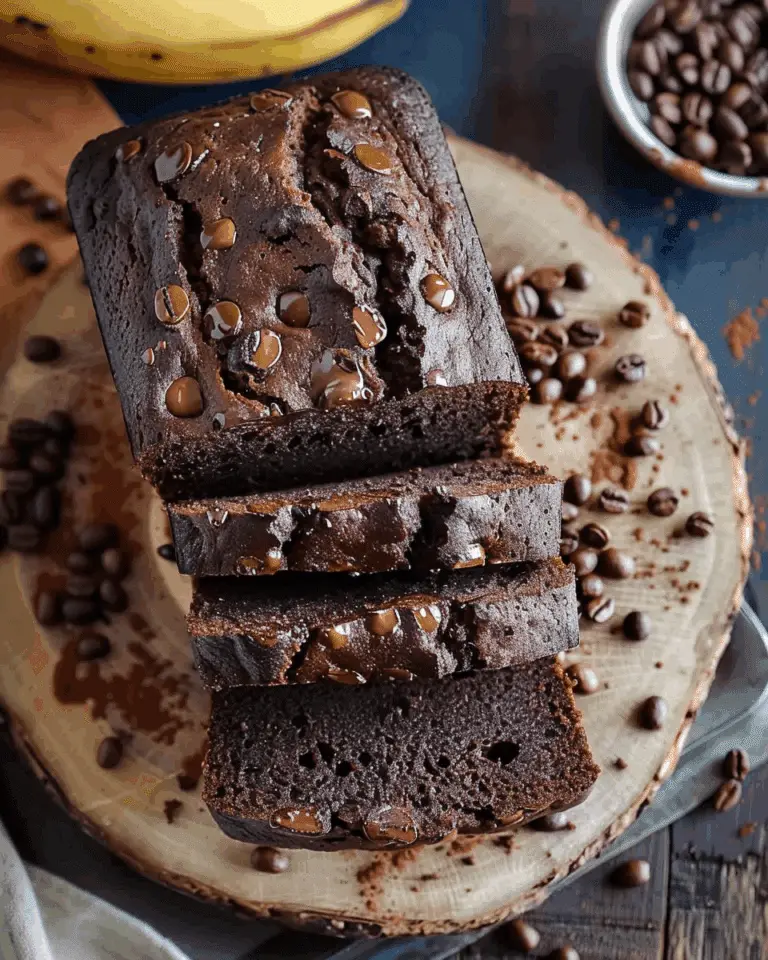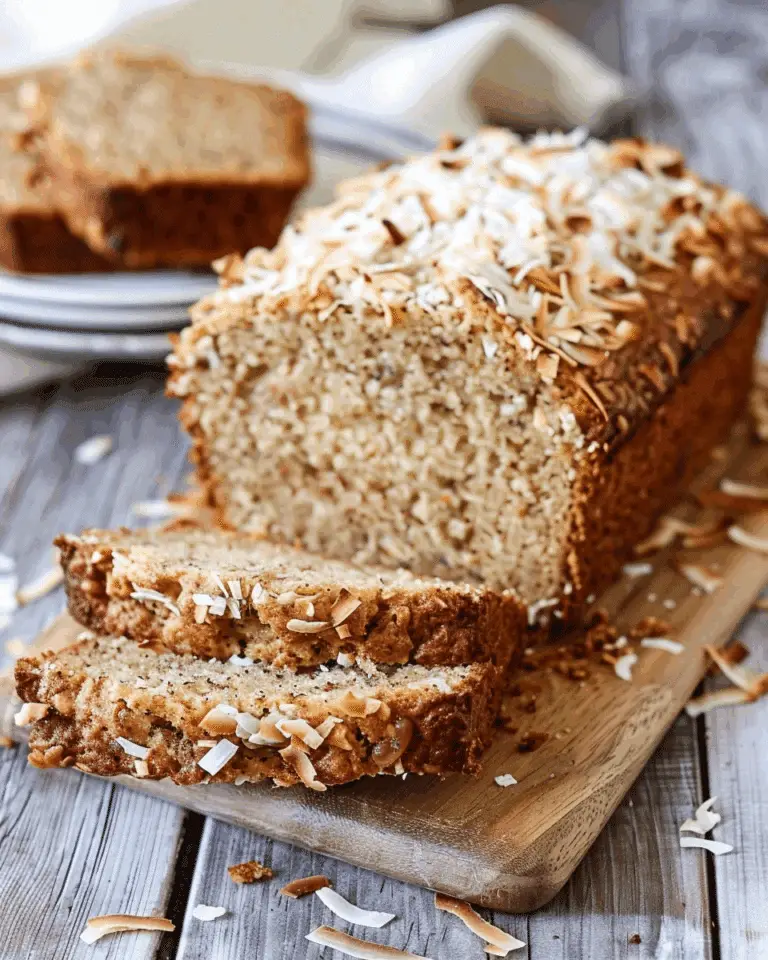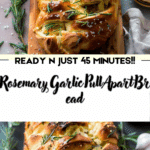Why You’ll Love Rosemary Garlic Pull Apart Bread Recipe
You’ll love this recipe because:
-
The flavor combination of garlic, rosemary, herbs and melty cheese gives every bite serious savory satisfaction.
-
The pull‑apart format means it’s fun and interactive — perfect for casual meals, gatherings, or when you want bread that’s more than just a side.
-
It uses a fairly straightforward dough (just nine basic ingredients) and then offsets that with a unique shape and filling to make it feel special.
-
Once you’ve made it, you’ll appreciate the contrast of crisp crust and soft, tender interior, which elevates it beyond typical dinner rolls.
-
It’s versatile: you can adjust the cheese, herbs or shape to make it your own.
Ingredients
(Tip: You’ll find the full list of ingredients and measurements in the recipe card below.)
Dough:
2 tsp instant yeast
1 Tbsp granulated sugar
¾ cup (180 ml) whole milk
3 Tbsp (43 g) unsalted butter, softened to room temperature
1 large egg
2⅓ cups (291 g) all‑purpose flour (spooned & leveled), plus more as needed
1 tsp salt
1 tsp garlic powder
1 Tbsp finely chopped fresh rosemary (or 2 tsp dried)
Filling:
5 Tbsp (71 g) unsalted butter, extra soft
1 Tbsp finely chopped fresh rosemary (or 2 tsp dried)
1 Tbsp finely chopped fresh parsley (or 2 tsp dried)
2 garlic cloves, minced (or ½ tsp garlic powder)
¼ tsp salt
¾ cup (95 g) shredded cheese (parmesan, mozzarella, white cheddar or your favourite)
Optional Topping:
1 Tbsp (14 g) unsalted butter, melted
Coarse or flaky sea salt for sprinkling
Directions
-
Make the dough: Place yeast and sugar in the bowl of a stand mixer fitted with a dough hook (or use a large mixing bowl if mixing by hand). Heat the milk until warm to the touch (about 110 °F / 43 °C). Pour the warm milk over the yeast/sugar, whisk gently, then loosely cover and let it sit for 5–10 minutes until frothy.
-
Add butter, egg, flour, salt, garlic powder and rosemary. Mix on low speed until the dough comes together and pulls away slightly from the bowl sides (about 3 minutes). If it’s too sticky, add flour a tablespoon at a time until manageable.
-
Knead the dough: Use the mixer with dough hook for about 5 minutes, or knead by hand on a lightly floured surface for 5 minutes. The dough should feel soft, slightly tacky, and when you poke it the indent slowly bounces back.
-
First rise: Shape the dough into a ball and place it in a greased bowl. Cover with plastic wrap or foil and let it rise in a warm spot until doubled in size, about 60–90 minutes.
-
As dough rises, prepare the filling: In a medium bowl, mix the extra‑soft butter with rosemary, parsley, garlic (or garlic powder) and salt. Set aside at room temperature. Grease a 9×5‑inch loaf pan.
-
After dough has risen, punch it down to release the air. Place dough on lightly floured surface and divide into 12 equal pieces (each about ¼ cup, slightly larger than a golf ball). Flatten each piece into a circle about 4 inches in diameter.
-
Spread about 1–2 teaspoons of the butter‑herb filling onto each dough circle. Sprinkle each with about 1 Tbsp of shredded cheese. Fold each circle in half and place it upright (folded side down, round side up) in the prepared loaf pan.
-
Second rise: Cover the pan with plastic wrap or foil and let the dough rise again in a warm spot until puffy, about 45 minutes.
-
Preheat oven to 350 °F (177 °C) and adjust the rack to the lower third position. Bake until golden brown, about 50 minutes. If the top browns too quickly, tent with foil for the remaining bake time.
-
Once baked, remove from oven and transfer the loaf pan to a wire rack. If using the optional topping: brush the melted butter over the top and sprinkle with coarse or flaky sea salt. Let the bread cool for about 10 minutes in the pan, then remove and serve warm.
Servings and timing
Yield: 1 loaf
Prep time: ~3 hours (mostly hands‑off during rises)
Bake time: ~50 minutes
Total time: ~4 hours (including rises and assembly)
Variations
-
Use different shredded cheeses: swap parmesan for cheddar, mozzarella, Gruyère or a blend for different flavour profiles.
-
Change the herbs: instead of rosemary and parsley you could use thyme, sage or a mix of dried Italian herbs.
-
Cheese‑free version: omit the shredded cheese entirely and maybe increase the butter‑herb filling slightly for richness.
-
Make individual pull‑apart buns instead of a loaf by shaping smaller rounds and placing them in a muffin tin.
-
Add a topping: after baking, drizzle a little garlic‑herb oil or sprinkle chopped fresh herb for a fresher finish.
Storage/Reheating
Store the bread covered at room temperature for up to 2 days, or in the refrigerator for up to 1 week. Because the exterior is extra‑crispy, it may begin to harden after day 1. To reheat and restore softness, warm in a 300 °F (149 °C) oven for 10–15 minutes until the interior is soft and warm, or heat individual pieces in the microwave for a shorter time.
FAQs
What type of yeast should I use?
You can use any instant dry yeast. If you happen to use active dry yeast instead, you may need to increase the rising times slightly.
Can I use 1% or skim milk instead of whole milk?
Yes, but whole milk gives a softer, richer texture. Using a lower‑fat milk may yield a slightly less tender crumb.
Do I need a stand mixer to make this dough?
No — you can mix by hand in a bowl and knead on a floured surface. It just requires a bit more manual effort for the kneading step.
Can I prep this ahead of time?
Yes. After the first rise (step 4), you can punch down the dough, cover it tightly, and refrigerate for up to 2 days. When ready, proceed with dividing, filling and the second rise.
Can I freeze the bread?
Yes — Once baked and fully cooled, wrap tightly and freeze for up to 3 months. Thaw at room temperature or overnight in the fridge, then warm in the oven as above.
What if the top of the loaf is browning too fast?
If the crust is getting too dark before the interior is done, tent loosely with aluminum foil for the remainder of the bake time.
Can I use whole wheat flour instead of all‑purpose?
You can substitute up to 1 cup of the flour with whole wheat flour, but it’s not recommended to replace all of it — the texture will be heavier.
What if I don’t have a 9×5‑inch loaf pan?
You might use a similarly sized pan, but keep in mind the loaf shape, bake time and internal texture may change. A smaller pan will result in a higher loaf or possible overflow.
Can I omit the cheese?
Yes— you can make the bread without the shredded cheese for a simpler herb‑butter version. The flavour will still be great, just less cheesy.
Why is the dough sticky and not pulling away from the bowl?
Doughs with higher moisture can still be correct. If it’s extremely sticky and unmanageable, add flour a tablespoon at a time until it comes together. But avoid adding too much, as you want a soft, slightly tacky dough for best texture.
Conclusion
This rosemary garlic pull‑apart bread is a standout loaf: simple in concept but rich in flavor and texture. Whether you’re baking it for a dinner side, a gathering with friends, or simply because you crave some irresistible homemade bread, you’ll find it worth the time and effort. Serve it warm, tear into those buttery cheesy layers, and enjoy the full experience of homemade bread at its best.

Rosemary Garlic Pull Apart Bread
5 Stars 4 Stars 3 Stars 2 Stars 1 Star
No reviews
- Author: Mia
- Total Time: 2 hours 5 minutes
- Yield: 1 loaf (about 8 servings)
- Diet: Vegetarian
Description
This Rosemary Garlic Pull-Apart Bread is a soft, fluffy, and flavorful yeast bread infused with fragrant rosemary and savory roasted garlic. Shaped in a fun pull-apart style, it’s perfect as a side dish or appetizer for any meal or gathering.
Ingredients
- 1 head of garlic
- 1 teaspoon olive oil
- 3 and 1/2 cups (440g) all-purpose flour, plus more for hands and surface
- 1 packet (2 and 1/4 teaspoons) Red Star Platinum yeast or instant yeast
- 1 teaspoon salt
- 1 tablespoon chopped fresh rosemary (plus more for topping)
- 1/4 teaspoon ground black pepper
- 1 cup (240ml) warm water (about 110°F/43°C)
- 1/4 cup (60ml) olive oil
- 1 large egg
- 2 tablespoons unsalted butter, melted (for brushing on top)
Instructions
- Roast the garlic: Preheat oven to 400°F (204°C). Slice the top off a head of garlic, drizzle with olive oil, wrap in foil, and roast for 30-35 minutes. Let cool, then squeeze out the cloves and mash into a paste.
- Make the dough: In a large bowl, mix flour, yeast, salt, rosemary, and black pepper. Add warm water, olive oil, egg, and roasted garlic. Stir to form a shaggy dough.
- Knead the dough: Transfer to a floured surface and knead for 5-6 minutes until smooth and elastic. Place in a greased bowl, cover, and let rise for 1 hour or until doubled.
- Shape the bread: Punch down the dough and divide into 40-45 small balls. Grease a 9×5-inch loaf pan. Layer the dough balls into the pan.
- Second rise: Cover and let rise for 30 minutes. Meanwhile, preheat the oven to 350°F (177°C).
- Bake: Brush the top with melted butter and sprinkle with more rosemary. Bake for 35-40 minutes until golden brown. If browning too quickly, tent with foil.
- Cool: Let cool for 10 minutes before serving. Best served warm.
Notes
- This bread is best enjoyed fresh but can be stored at room temperature for up to 2 days or frozen for longer storage.
- To reheat, warm in the oven at 300°F (149°C) for about 10 minutes.
- You can substitute dry rosemary if fresh isn’t available, but reduce the amount to 1 teaspoon.
- Prep Time: 1 hour 30 minutes
- Cook Time: 35 minutes
- Category: Bread
- Method: Baking
- Cuisine: American
Nutrition
- Serving Size: 1 slice (1/8 of loaf)
- Calories: 230
- Sugar: 1g
- Sodium: 210mg
- Fat: 9g
- Saturated Fat: 2g
- Unsaturated Fat: 6g
- Trans Fat: 0g
- Carbohydrates: 31g
- Fiber: 1g
- Protein: 5g
- Cholesterol: 25mg








